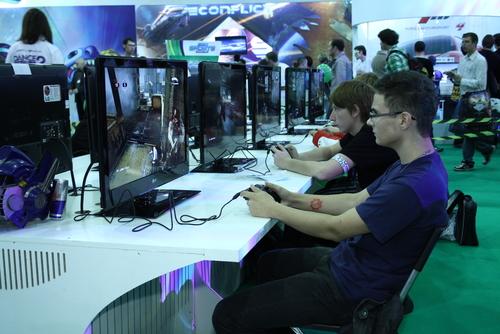AMD's Radeon Sky Optimized for Cloud Gaming
It's a PC GPU—but in the data center! AMD has unveiled its Radeon Sky architecture, which leverages its "Tahiti" and "Pitcairn" GPUs for cloud computing. Nvidia will release three cards based on the technology: the Radeon Sky 500, 700, and 900. AMD product manager Mohammad Jivraj said that the Radeon Sky will be placed in racks and data centers and specifically optimized to stream PC games—meaning that the games themselves are "played" in a rack contained within a remote server, with the graphics streamed to a PC, micro-console, or tablet. Controller movements are sent back upstream to the server. The company named three customers in the space, including Otoy, CiiNow, and G-Cluster Global. Cloud gaming had its heyday in early 2012, thanks in large part to the rise of OnLive. But after OnLive went through a painful corporate transition, and rival Gaikai was bought (and vanished into) Sony, cloud gaming sort of stalled. "It's definitely a niche right now," Jivraj said. "Ultimately, we're looking at partnerships to make this a reality." High-performance computing companies could begin buying the Radeon Sky cards and use them as alternatives to the Intel Xeon Phi and products such as the Nvidia VCA—hardware designed for "remote graphics" applications. Nvidia has also launched a series of GPUs designed around its CUDA compute language and optimized for the repetitive calculations of high-performance computing. Jivraj said that Radeon Sky relies on technology designed for the FirePro line of workstation graphics cards, but includes RapidFire, a combination of hardware and software—including an open API—that simplifies the manipulation of key hardware controls to provide HD visual quality, minimal latency and optimal network bandwidth. Both the Radeon Sky 700 and 900 cards require two slots and include 6 GB of DRAM; the 500 requires just one, and includes 4 GB. According to AMD and a slide published by Hot Hardware, the Radeon Sky 900 runs at 825 MHz, but contains 3,584 stream processors; the 900 runs at 900 MHz, and includes 1,792 stream processors; and the 500 runs at 950 MHz, and includes 1,280 stream processors. All three cards will ship in the second quarter, Jivraj said. Pricing has not yet been determined. Earlier this year, AMD’s cash situation was precarious—does the cloud-gaming market give it a chance to earn the revenue it needs? Image: Dikiiy/Shutterstock.com

